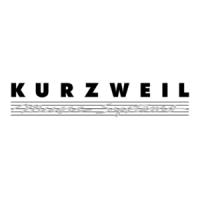
Do you have a question about the Kurzweil K2600 - MUSICIANS GUIDE REV A PART NUMBER 910330 CHAP 6 and is the answer not in the manual?
| Brand | Kurzweil |
|---|---|
| Model | K2600 - MUSICIANS GUIDE REV A PART NUMBER 910330 CHAP 6 |
| Category | Synthesizer |
| Language | English |
Overview of Program Mode and the differences between VAST and KB3 programs.
Details the hierarchical structure of VAST programs, from samples to setups.
Explains the oscillator-based architecture of KB3 programs and their unique characteristics.
Discusses key aspects of using KB3 programs, including controls and channel assignments.
How to control KB3 effects and parameters using sliders and buttons.
How to control KB3 programs using external MIDI sources and controller numbers.
Overview of the main display and information shown in Program Mode.
Defines how physical controllers are assigned to programs in Program Mode.
Introduction to modifying VAST programs using the Program Editor.
Explains algorithms as signal paths using DSP functions.
Details common parameters used across different DSP functions for sound shaping.
Interface for selecting algorithms and assigning DSP functions to layers.
Parameters for defining a layer's keyboard range, velocity, and envelope responses.
Controls sample root selection, transposition, and other keymap-specific settings.
Parameters for adjusting the pitch and fine-tuning of samples.
Controls the final amplitude of a layer before audio output.
Parameters for routing a layer's signal to KDFX and setting output configurations.
Frequently-used parameters affecting the entire program.
Shaping the attack, decay, and release characteristics of a layer's amplitude.
Real-time control over envelope section rates.
Defines low-frequency oscillators for modulation effects like vibrato and tremolo.
Controls Attack, Sustain, Release envelopes triggered by control sources.
Combining control sources using mathematical functions for advanced modulation.
Triggering events based on note velocity thresholds.
Assigning and controlling effects studios in real-time.
Further FXMod parameters for controlling KDFX effects.
Explains various soft buttons for program editing tasks.
Introduction to editing KB3 programs and their specific parameters.
Parameters for defining tone wheel characteristics in KB3 programs.
Editing drawbar settings for KB3 programs.
Controls percussion settings for KB3 programs.
Fine-tuning percussion amplitude and decay for KB3 programs.
Parameters for the key click feature in KB3 programs.
Amplitude control parameters specific to KB3 programs.
Miscellaneous control parameters including Leslie and vibrato/chorus.
Equalization settings to shape tone wheel frequencies.
Guidance and examples for creating custom KB3 programs.












